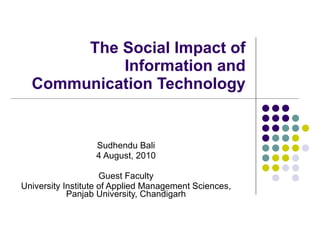
The Social Impact of ICT
- 1. The Social Impact of Information and Communication Technology Sudhendu Bali 4 August, 2010 Guest Faculty University Institute of Applied Management Sciences, Panjab University, Chandigarh
- 4. More jobs : Computer manufacturers, delivery drivers, call centre employees, etc. Skills : Constant retraining needed More flexibility : No longer jobs for life Working patterns : More flexible employment/working, more part time working Telecommuting : Working from home Jobs New jobs : Programmers, web designers, ICT teachers, etc. Fewer jobs : Filing clerks, shop workers, postal workers; manual/repetitive jobs replaced
- 10. Other: Paperless office, teleconferencing Robots : Used on production lines – repetitive/hazardous jobs, reduces human error, increases efficiency Computer Aided Manufacture (CAM) : Control of the manufacture process by computer Internet : Drastically changed the businesses operate Business Computer Aided Design (CAD) : 3D designs, scale drawings, interface with manufacturing machines Teleworking : Fewer desks needed – hot desking, workers control the times they work, etc.
- 13. Electronic Funds Transfer Home Banking : Customers use the internet or telephone to administer their account Cheque Processing: Cheques are scanned, account numbers read (MICR) to identify the account EFT : Credit/Debit card details sent for authorisation, from retailers or ATMs Credit/Debit Cards: Magnetic stripe holds the card details which are read when swiped Cash Machines: Automated Teller Machine (ATM) – “hole in the wall” access to bank accounts Smart Cards : Chip and Pin – data held on a small silicon chip rather than magnetic stripe, customer enters a pin rather than signs receipt Money and Banking Automated Payments : Bankers Automated Clearing House (BACS) – Credits, e.g. salary payments, etc.; Debits, e.g. direct debits, loan payments, etc.
- 18. The Patient at the Center of Care Courtesy of Paul Wallace, Kaiser
- 19. Monitoring/Diagnosis : Heart rate, blood pressure, etc. Expert systems, CAT scans NHSnet : Project to connect all GP surgeries, networked to hospitals NHS Direct : Web site for information on health care, treatments, conditions, etc. Hospital Administration : Patient attendance, print labels, allocate beds, order food, make appointments, send letters, staff rotas Pharmacy records : Contra-indications, stock Medical Training : Simulation software, on-line data sources Health Patient Records : Held electronically, rather than paper files
- 22. Letters : Mail merge not typed on a typewriter Timetables : Generated by computer Computer Aided Learning : On-screen learning materials, computer aided assessment Registration : OMR registers, scanned to update central database, produce absence lists Reports : Produced electronically, e.g. mail merge Records : Details of all pupils held on file, reduces administration Teaching : Interactive whiteboards, internet, projectors Education
- 24. Mobile telephones : Can send voice, image, text, data (from a linked computer) Fax : Sending an image of a document electronically Tele/Video Conferencing: people in different locations communicating as if they were in the same location E-mail : Message sent from 1 person to another using computers connected to a network WWW: World Wide Web – collection of pages with links to other pages (hyperlinks) Internet: Largest WAN, international network of computers connected by communication lines Connection Methods : Cable, radio/microwaves, infra-red, satellite, etc. Networks : LANs or WANs Communication
